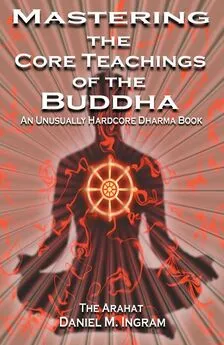Daniel Ingram - Mastering the Core Teachings of Buddha - An Unusually Hardcore Dharma Book
- Название:Mastering the Core Teachings of Buddha - An Unusually Hardcore Dharma Book
- Автор:
- Жанр:
- Издательство:Aeon Books
- Год:2009
- ISBN:9781904658405
- Рейтинг:
- Избранное:Добавить в избранное
-
Отзывы:
-
Ваша оценка:
Daniel Ingram - Mastering the Core Teachings of Buddha - An Unusually Hardcore Dharma Book краткое содержание
Mastering the Core Teachings of Buddha - An Unusually Hardcore Dharma Book - читать онлайн бесплатно полную версию (весь текст целиком)
Интервал:
Закладка:
vii
Foreword and Warning
As a highly regarded senior meditation teacher and scholar (who will remain anonymous) said to me after skimming through an earlier draft of this book, “Most Buddhists are just aging Boomers who want to do something to feel better about themselves as they get older and are not really interested in this sort of thing.” I wish them great success in getting those valid needs met and so I must reluctantly advise such individuals to avoid reading this book or at least the chapters marked with a star.
This is simultaneously an admission of the limitations of this work, an invitation to adopt a more empowering view of what is possible on the spiritual path, and a warning.
I have had other motivations for writing this book. A number of people have attempted to have me be their meditation teacher. I have done what I can to encourage them to practice well, go on retreats and explore, but as soon as I get the sense that they are not into really doing the work or are trying to idolize me in even small ways, I go out of my way to alienate them completely. I greatly prefer the company of fellow adventurers who wish to explore the mysteries of this life together than any other sort of relationship. Dharma friends may be at different stages in the practice and one friend may teach another something useful, but this has a very different feel from people who are formally teacher and student. Thus, writing this book allows me to hand them the better part of what I know and say, “Here, if you are really into it, there is more than enough here to allow you to plunge as deep as you care to. If not, I have wasted little of my time and can avoid being put on some strange pedestal or pillory, at least to my face.”
That said, I do have the explicit goal of facilitating others to become living masters of this material that they may go forth and help to encourage more people to do so. The more people are able to teach from a place of deeply established personal experience, the more people will be able to learn the dharma well, and the saner and happier the world will be.
This brings me to the question of the issue of what some would call hierarchy. The simple fact is that there are those that have attained to what is called awakening, enlightenment, realization, etc. and those that haven't. There are those with strong concentration abilities and those those without. There are those who have their morality trip together and viii
Foreword and Warning
those that don't. There are those who are masters of some things and those that have more work to do. While there is a strangely pervasive movement in the West to try to imagine everyone is equal in the world of spirituality, it is obviously completely delusional and wrong-headed.
When I went looking for teachers and friends to practice with and help me along, rather than get mad that some people claimed to know more than I did, I was excited by the opportunity, however rare, to study with people who knew what they were doing. This just makes sense. Read this as another warning: if you get good enough at these things, people will often have bad reactions to you if you go around talking about it, and the number who will instead find your achievements a source of inspiration and empowerment, as they rightly should, will likely be few.
On that same front, it is a very strange thing to have such a completely different language, set of experiences and perspectives from most of the people around me. I can often feel like an alien wearing a trench coat of normalcy, and I dream of a world where conversations about the sorts of events and insights that have come to dominate my everyday experience are much more common and normal. Reading between the lines, you should take this admission as yet another warning. If you get way into this stuff, you will discover this same loneliness.
I should also mention that I consider myself and many of those who hail from the lineages from which I primarily draw to be dharma cowboys, mavericks, rogues, and outsiders. Really wanting to get somewhere is a sure ticket to feeling this way in most Western Buddhist circles. What is ironic is that I also see myself as an extreme traditionalist. The strange thing is that these days to be a Buddhist traditionalist, one who really tries to plunge the depths of the heart, mind and body as the Buddha so clearly admonished his followers to do, is to fly in the face of much of mainstream meditation culture.
In that same vein, I should further mention that the path I have followed has been dangerous, destabilizing more often than calm, excruciating more often than pleasant, harder to integrate than most other dharma paths I have heard of, and in general quite a rough ride. It has also been profound, amazing, and more glorious than most other paths I have heard tell of. Surfing the ragged edges of reality has been ix
Foreword and Warning
easier for me than slowing the thing down. In my explorations, accidents and adventures, I have learned a lot about not only how to make very fast progress in meditation but also a lot about how to do so without completely wiping out. I hope that I can pass on some of the knowledge of both in this book. This should be seen as another warning. This book and the path presented in it are not for the damaged and unstable spiritual seeker. You have to have your psychological trip fairly together to be able to handle the intense techniques, side effects and results I am about to discuss.
I would like to thank the very many people whose influence,
friendship, support and kindness went into making this work what it is, though they are way too numerous to list here. This is an
interdependent universe, and so to write that this work is simply by me is not in accord with reality. It would be absurd not to acknowledge the extensive support of Carol Ingram, Sonja Boorman, David Ingram, Christina Jones, Christopher Titmuss, Sharda Rogell, Bill Hamilton, Kenneth Folk and Robert Burns, all of who were very instrumental in making what is good in this book and my own practice possible. I would also like to thank John Hawley, Roger Windsor, Daniel Rizzuto and Michael Wade for all their help with editing. However, the
responsibility for any flaws this work may contain must fall squarely on me. I can’t be sure that all of these fine people would even want their names associated with this work, but I reserve the right to express my deep gratitude nonetheless.
A brief note on style… The English language has no great way to use pronouns that refer to a single person without getting gender-specific.
Various solutions exist, such as constantly using “he/she” (which can be very distracting), alternating between “he” and “she”, and recasting sentences in the plural, where the pronoun “they” may be used. For better or for worse, I am going to use the pronoun “they” to mean
“he/she,” thus using what is ordinarily a plural pronoun with verbs in the singular. I am not particularly thrilled with this solution, but I don’t think it is much worse than the others. Should a reader disagree, I hope that he/she will find a way to forgive me, or at least that she will understand the problem, making room in his heart for one more author struggling with this linguistic limitation. I must also admit that I am x
Foreword and Warning
somewhat erratic in my use of capital letters, and you may just have to Live With It.
May this work be for the benefit of all beings. May you realize what you are truly looking for, pursue it relentlessly despite all obstacles, and find it.
xi
PART I: THE FUNDAMENTALS
1
1.INTRODUCTION TO PART I
If you didn’t read the Foreword and Warning, do so now.
The Buddhist path has often been called a “spiritual path,” and this use of religious language can be very inspiring for some people. The Buddhist path could also be thought in terms of a scientific experiment, a set of exercises that the Buddha and those who have followed him have claimed lead to very specific effects, effects that they deemed worthwhile. Using this sort of practical language can also be very inspiring for some people. In an attempt to inspire a wide audience, I will use both spiritual and practical or technical language when discussing these issues. However, my preference is generally for the practical language. You could throw out all of the spiritual trappings on the Buddhist path and still have a set of basic practices that lead to the effects promised. You could also keep all of the spiritual trappings, do the basic practices, and produce the same results, assuming of course that you had the extra time and resources necessary to do both.
Part I contains some traditional lists that were taught by the Buddha and relate directly to spiritual training. They make important and practical points in very concise ways. These teachings were made compact and portable on purpose so that people could remember them and use them. It is their very simplicity that makes them so practical and down to earth.
I, however, am going to take these very compact teachings and go on and on about them. It turns out that the Buddha sometimes made things so simple that we are left wondering what the heck he was talking about and how to do something useful with his teachings. Basically he was saying, “Get to know your actual reality really, really, really well, and try to do right by yourself and the world.” As we all know, this is not always as easy as it sounds, so that is why I include all of the additional commentary.
Thus, these teachings are designed to help people get in touch with their reality in some way that makes a difference. They can also help people avoid some of the common pitfalls on the spiritual path and in life in general, some of which I will talk about later.
To that end, we will begin with an introduction to the Three Trainings, morality , conce ntratio n and wisdom . The Three
Introduction to Part I
Trainings encompass the sum total of the Buddhist path. Thus, they will be used as the framework for this book. The Three Trainings involve skills that we consciously and explicitly try to master. Each training has its own specific set of assumptions, agendas, practices, and standards for success in those practices. These are actually fairly different from each other, and all sorts of problems can arise if we mix these up and use the assumptions of one training when pursuing the others. Each training also has its common pitfalls, limitations, and shadow sides. These are rarely made clear, and the failure to do so has caused much confusion.
Thus, I will do my best to make them clear, particularly in Part II (Light and Shadows). Each training also has specific standards for success and mastery. These can sometimes seem a bit technical, particularly the maps of the high concentration states and the stages of insight, so I will wait until Part III (Mastery) to present these in order to keep Part I focused on the basic frameworks and practices that make the whole thing possible in the first place.
While I think that each part of this book contributes to the whole, there are reasons why you might want to skip to certain sections first and fill in the rest later. For instance, if you are having powerful visions or Kundalini experiences, you might want to read the first few chapters of Part III and then go back and read the rest. If you are simply interested in the maps of the stages of insight, go straight to the chapter called The Progress of Insight. If you just want to get right to some core insight practices, read the chapters on The Three Characteristics and The Seven Factors of Enlightenment. Should you be in a mood for some scathing social commentary, the beginning of Part II is for you. If you just want to hear my take on enlightenment, then Models of the Stages of Enlightenment might be a good place to start. I struggled for a long time debating whether to present the maps that tell what these practices lead to at the beginning or at the end of the book. I have included them last, but you might be the sort who wants to see them first, and if so you should read the chapter called The Three Characteristics and then skip straight to Part III. In my ideal world, everyone would read through this book two or three times cover-to-cover and then work on committing the more important sections to memory.
Читать дальшеИнтервал:
Закладка:





![Дженнифер Гюнтер - The vagina book. Главная книга для тех, у кого есть этот орган [litres]](/books/1061538/dzhennifer-gyunter-the-vagina-book-glavnaya-kniga-dl.webp)




